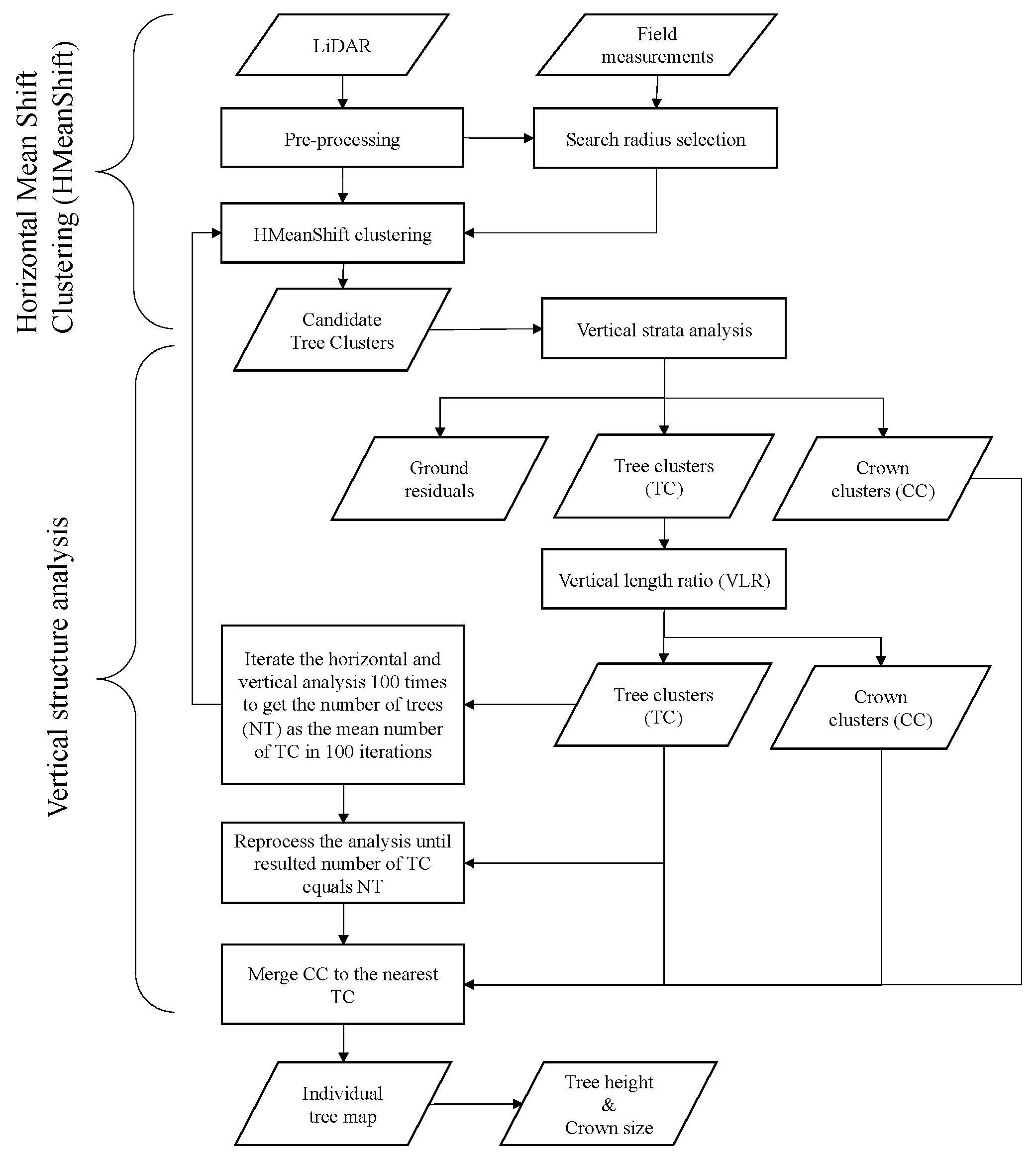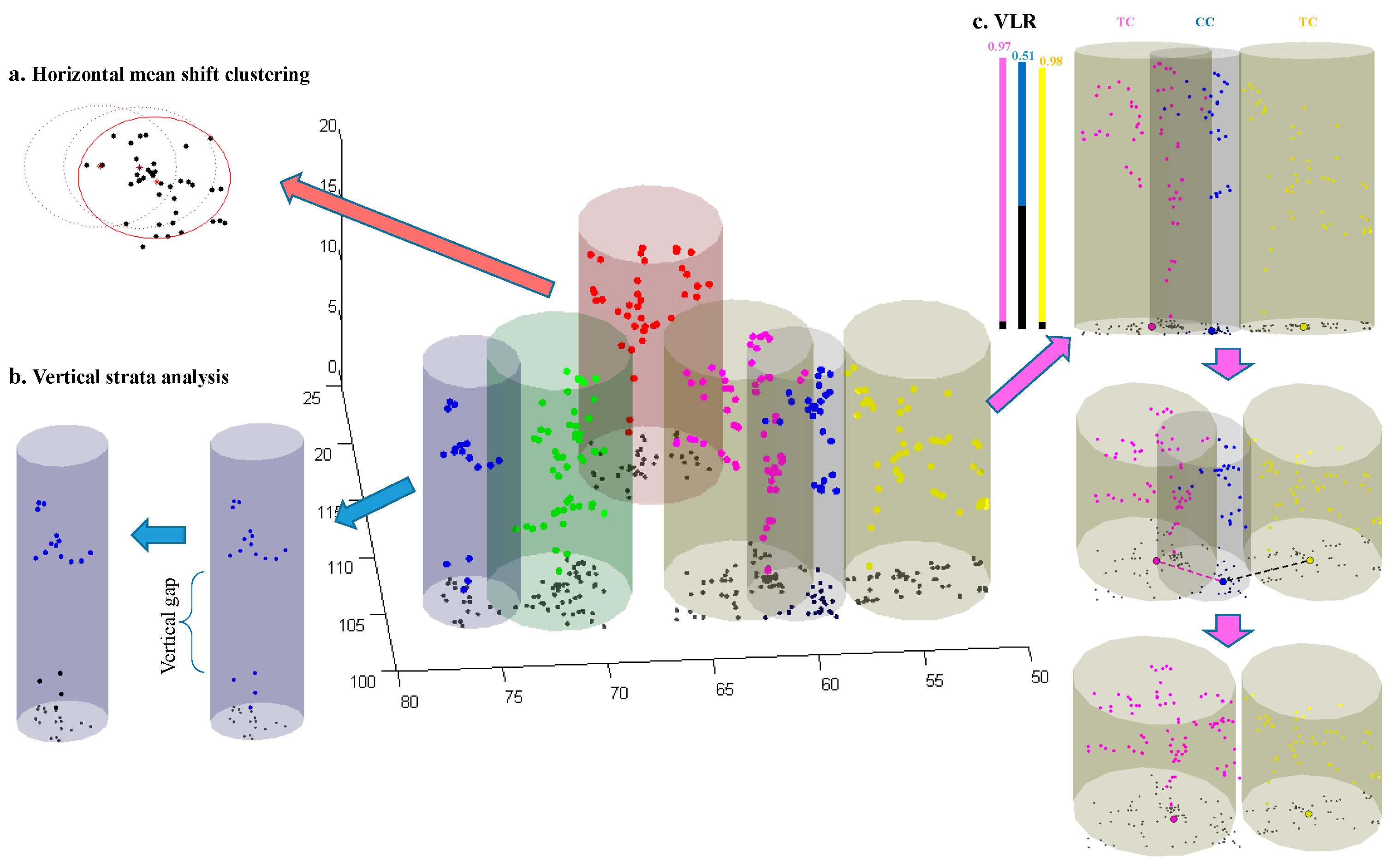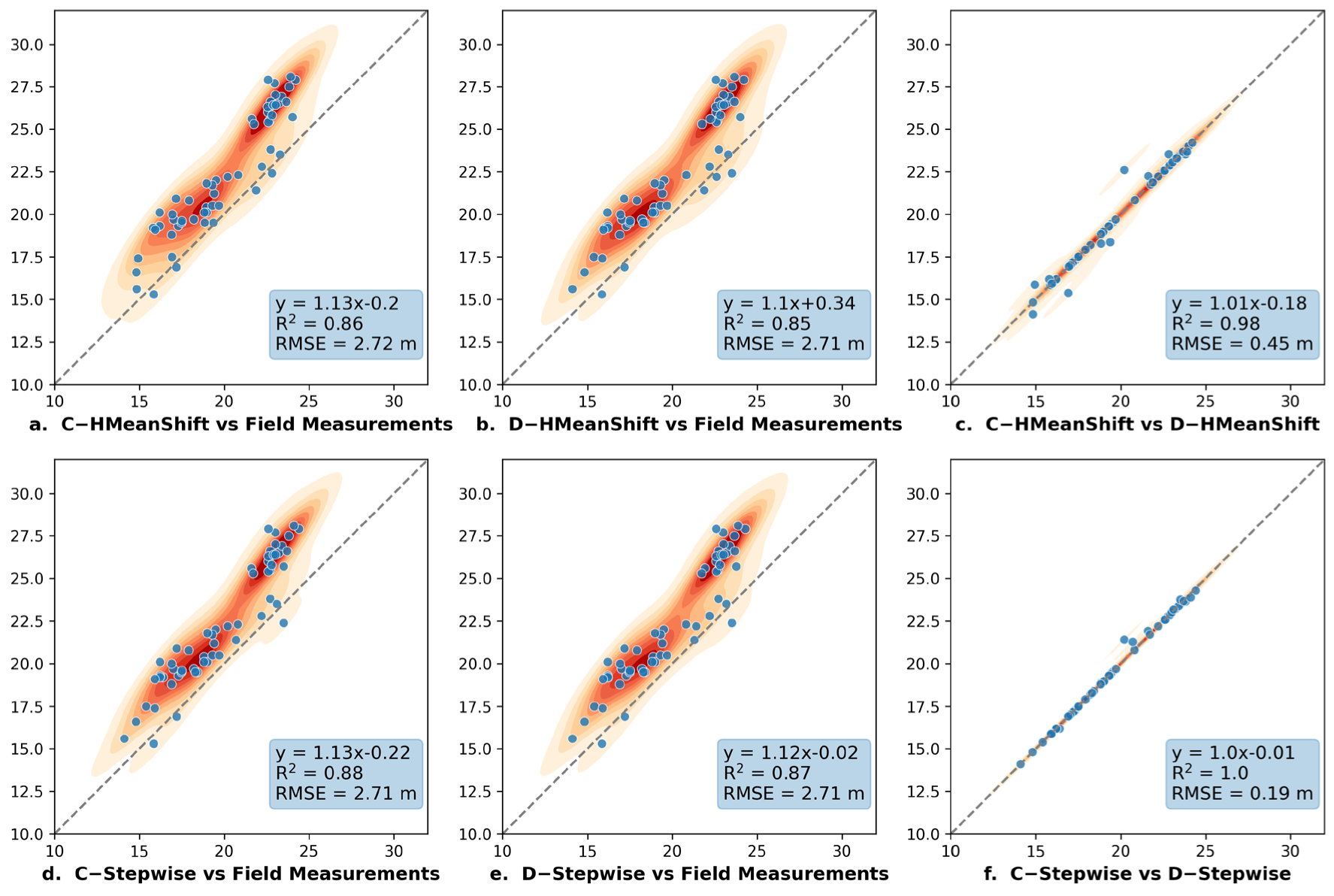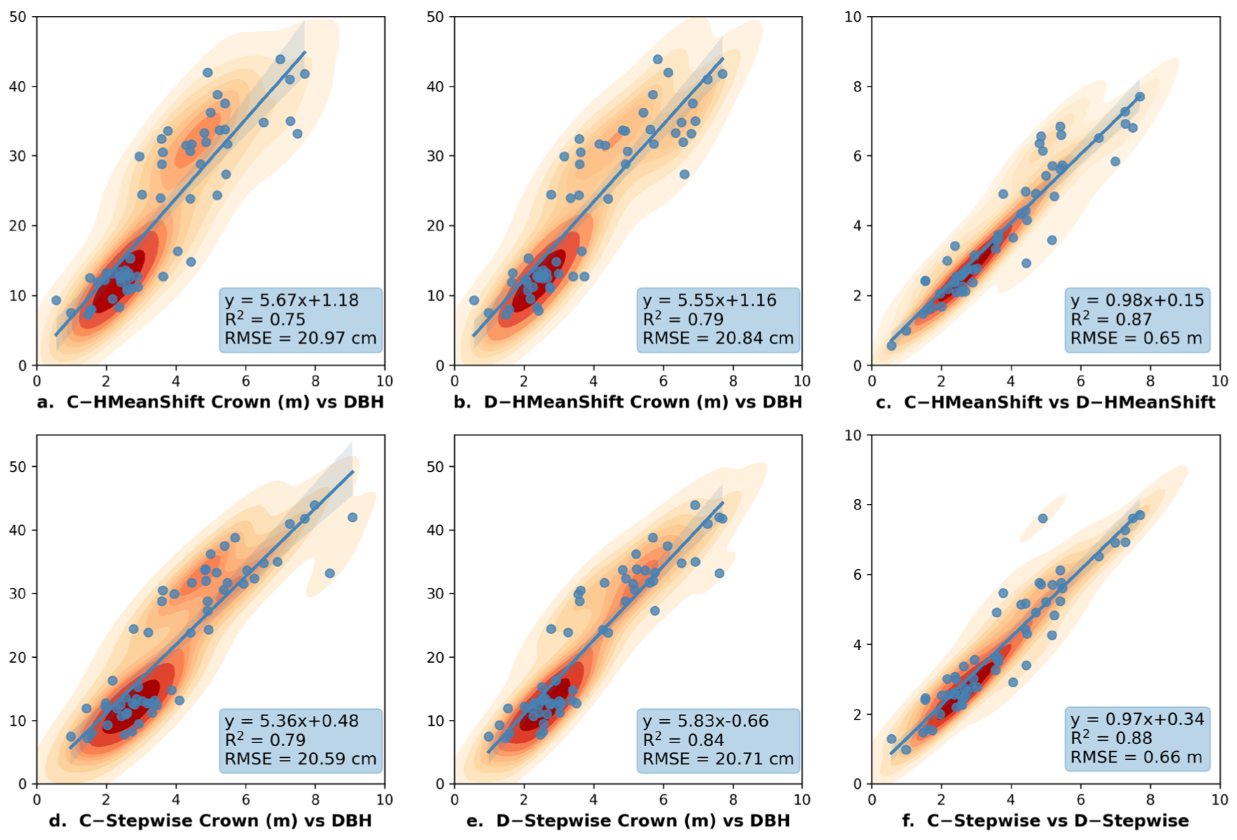A Robust Stepwise Clustering Approach to Detect Individual Trees in Temperate Hardwood Plantations using Airborne LiDAR Data
Abstract
1. Introduction
2. Data and Methods
2.1. Study Area
2.2. Field Data
2.3. LiDAR Data and Pre-Processing
2.4. Stepwise Tree Detection Approach
2.4.1. HMeanShift Clustering
2.4.2. HMeanShift Search Kernel Selection
2.4.3. Vertical Structure Analysis
2.4.4. Clustering Optimization and Individual Tree Parameter Estimation
2.5. Algorithm Validation
2.5.1. Accuracy Assessment of Individual Tree Detection
2.5.2. Validation of the Individual Tree Parameter Estimation
3. Results
3.1. Assessment of Single-Step HMeanShift
3.2. Assessment of the Stepwise Approach
3.3. Validation of Tree Height Estimation
3.4. Validation of Canopy Crown Estimation
4. Discussion
4.1. Detection Accuracy of the Stepwise Approach
4.2. Impacts of the Clustering Kernel of Mean Shift on the Tree Detection
4.3. Efficiency of the Stepwise Approach
4.4. Field Measurements and Tree Height Underestimation
4.5. Limitations and Uncertainties
5. Conclusions
Supplementary Materials
Author Contributions
Funding
Data Availability Statement
Conflicts of Interest
References
- Latella, M.; Sola, F.; Camporeale, C. A Density-Based Algorithm for the Detection of Individual Trees from LiDAR Data. Remote Sens. 2021, 13, 322. [Google Scholar] [CrossRef]
- Picos, J.; Bastos, G.; Míguez, D.; Alonso, L.; Armesto, J. Individual Tree Detection in a Eucalyptus Plantation Using Unmanned Aerial Vehicle (UAV)-LiDAR. Remote Sens. 2020, 12, 885. [Google Scholar] [CrossRef]
- Duncanson, L.; Cook, B.; Hurtt, G.; Dubayah, R. An Efficient, Multi-Layered Crown Delineation Algorithm for Mapping Individual Tree Structure across Multiple Ecosystems. Remote Sens. Environ. 2014, 154, 378–386. [Google Scholar] [CrossRef]
- Lim, K.; Treitz, P.; Wulder, M.; St-Onge, B.; Flood, M. LiDAR Remote Sensing of Forest Structure. Prog. Phys. Geogr. 2003, 27, 88–106. [Google Scholar] [CrossRef]
- Wulder, M.A.; White, J.C.; Nelson, R.F.; Næsset, E.; Ørka, H.O.; Coops, N.C.; Hilker, T.; Bater, C.W.; Gobakken, T. Lidar Sampling for Large-Area Forest Characterization: A Review. Remote Sens. Environ. 2012, 121, 196–209. [Google Scholar] [CrossRef]
- Hyde, P.; Nelson, R.; Kimes, D.; Levine, E. Exploring LiDAR–RaDAR Synergy—Predicting Aboveground Biomass in a Southwestern Ponderosa Pine Forest Using LiDAR, SAR and InSAR. Remote Sens. Environ. 2007, 106, 28–38. [Google Scholar] [CrossRef]
- Næsset, E.; Gobakken, T. Estimation of Above- and below-Ground Biomass across Regions of the Boreal Forest Zone Using Airborne Laser. Remote Sens. Environ. 2008, 112, 3079–3090. [Google Scholar] [CrossRef]
- Bergen, K.; Goetz, S.; Dubayah, R.; Henebry, G.; Hunsaker, C.; Imhoff, M.; Nelson, R.; Parker, G.; Radeloff, V. Remote Sensing of Vegetation 3-D Structure for Biodiversity and Habitat: Review and Implications for Lidar and Radar Spaceborne Missions. J. Geophys. Res. Biogeosci. 2009, 114, G2. [Google Scholar] [CrossRef]
- Hudak, A.T.; Strand, E.K.; Vierling, L.A.; Byrne, J.C.; Eitel, J.U.; Martinuzzi, S.; Falkowski, M.J. Quantifying Aboveground Forest Carbon Pools and Fluxes from Repeat LiDAR Surveys. Remote Sens. Environ. 2012, 123, 25–40. [Google Scholar] [CrossRef]
- Lichstein, J.W.; Dushoff, J.; Ogle, K.; Chen, A.; Purves, D.W.; Caspersen, J.P.; Pacala, S.W. Unlocking the Forest Inventory Data: Relating Individual Tree Performance to Unmeasured Environmental Factors. Ecol. Appl. 2010, 20, 684–699. [Google Scholar] [CrossRef] [PubMed]
- Crowther, T.W.; Glick, H.B.; Covey, K.R.; Bettigole, C.; Maynard, D.S.; Thomas, S.M.; Smith, J.R.; Hintler, G.; Duguid, M.C.; Amatulli, G. Mapping Tree Density at a Global Scale. Nature 2015, 525, 201–205. [Google Scholar] [CrossRef] [PubMed]
- Kaartinen, H.; Hyyppä, J.; Yu, X.; Vastaranta, M.; Hyyppä, H.; Kukko, A.; Holopainen, M.; Heipke, C.; Hirschmugl, M.; Morsdorf, F. An International Comparison of Individual Tree Detection and Extraction Using Airborne Laser Scanning. Remote Sens. 2012, 4, 950–974. [Google Scholar] [CrossRef]
- Popescu, S.C.; Wynne, R.H.; Nelson, R.F. Measuring Individual Tree Crown Diameter with Lidar and Assessing Its Influence on Estimating Forest Volume and Biomass. Can. J. Remote Sens. 2003, 29, 564–577. [Google Scholar] [CrossRef]
- Ferraz, A.; Bretar, F.; Jacquemoud, S.; Gonçalves, G.; Pereira, L.; Tomé, M.; Soares, P. 3-D Mapping of a Multi-Layered Mediterranean Forest Using ALS Data. Remote Sens. Environ. 2012, 121, 210–223. [Google Scholar] [CrossRef]
- Jakubowski, M.K.; Li, W.; Guo, Q.; Kelly, M. Delineating Individual Trees from LiDAR Data: A Comparison of Vector-and Raster-Based Segmentation Approaches. Remote Sens. 2013, 5, 4163–4186. [Google Scholar] [CrossRef]
- Yao, W.; Krzystek, P.; Heurich, M. Tree Species Classification and Estimation of Stem Volume and DBH Based on Single Tree Extraction by Exploiting Airborne Full-Waveform LiDAR Data. Remote Sens. Environ. 2012, 123, 368–380. [Google Scholar] [CrossRef]
- Koch, B.; Kattenborn, T.; Straub, C.; Vauhkonen, J. Segmentation of Forest to Tree Objects. For. Appl. Airborne Laser Scanning 2014, 27, 89–112. [Google Scholar]
- Culvenor, D.S. TIDA: An Algorithm for the Delineation of Tree Crowns in High Spatial Resolution Remotely Sensed Imagery. Comput. Geosci. 2002, 28, 33–44. [Google Scholar] [CrossRef]
- Chen, Q.; Baldocchi, D.; Gong, P.; Kelly, M. Isolating Individual Trees in a Savanna Woodland Using Small Footprint Lidar Data. Photogramm. Eng. Remote Sens. 2006, 72, 923–932. [Google Scholar] [CrossRef]
- Koch, B.; Heyder, U.; Weinacker, H. Detection of Individual Tree Crowns in Airborne Lidar Data. Photogramm. Eng. Remote Sens. 2006, 72, 357–363. [Google Scholar] [CrossRef]
- Solberg, S.; Næsset, E.; Hanssen, K.H.; Christiansen, E. Mapping Defoliation during a Severe Insect Attack on Scots Pine Using Airborne Laser Scanning. Remote Sens. Environ. 2006, 102, 364–376. [Google Scholar] [CrossRef]
- Popescu, S.C.; Wynne, R.H.; Nelson, R.F. Estimating Plot-Level Tree Heights with Lidar: Local Filtering with a Canopy-Height Based Variable Window Size. Comput. Electron. Agric. 2002, 37, 71–95. [Google Scholar] [CrossRef]
- Li, Y.; Chai, G.; Wang, Y.; Lei, L.; Zhang, X. ACE R-CNN: An Attention Complementary and Edge Detection-Based Instance Segmentation Algorithm for Individual Tree Species Identification Using UAV RGB Images and LiDAR Data. Remote Sens. 2022, 14, 3035. [Google Scholar] [CrossRef]
- Hu, B.; Li, J.; Jing, L.; Judah, A. Improving the Efficiency and Accuracy of Individual Tree Crown Delineation from High-Density LiDAR Data. Int. J. Appl. Earth Obs. Geoinf. 2014, 26, 145–155. [Google Scholar] [CrossRef]
- Tang, X.; You, H.; Liu, Y.; You, Q.; Chen, J. Monitoring of Monthly Height Growth of Individual Trees in a Subtropical Mixed Plantation Using UAV Data. Remote Sens. 2023, 15, 326. [Google Scholar] [CrossRef]
- Gleason, C.J. A Fusion Approach for Tree Crown Delineation from Lidar Data. Photogramm. Eng. Remote Sens. 2012, 78, 679–692. [Google Scholar] [CrossRef]
- Wagner, W.; Hollaus, M.; Briese, C.; Ducic, V. 3D Vegetation Mapping Using Small-footprint Full-waveform Airborne Laser Scanners. Int. J. Remote Sens. 2008, 29, 1433–1452. [Google Scholar] [CrossRef]
- Morsdorf, F.; Meier, E.; Kötz, B.; Itten, K.I.; Dobbertin, M.; Allgöwer, B. LIDAR-Based Geometric Reconstruction of Boreal Type Forest Stands at Single Tree Level for Forest and Wildland Fire Management. For. Fire Prev. Assess. 2004, 92, 353–362. [Google Scholar] [CrossRef]
- Reitberger, J.; Schnörr, C.; Krzystek, P.; Stilla, U. 3D Segmentation of Single Trees Exploiting Full Waveform LIDAR Data. ISPRS J. Photogramm. Remote Sens. 2009, 64, 561–574. [Google Scholar] [CrossRef]
- Lee, H.; Slatton, K.C.; Roth, B.E.; Cropper, W., Jr. Adaptive Clustering of Airborne LiDAR Data to Segment Individual Tree Crowns in Managed Pine Forests. Int. J. Remote Sens. 2010, 31, 117–139. [Google Scholar] [CrossRef]
- Li, W.; Guo, Q.; Jakubowski, M.K.; Kelly, M. A New Method for Segmenting Individual Trees from the Lidar Point Cloud. Photogramm. Eng. Remote Sens. 2012, 78, 75–84. [Google Scholar] [CrossRef]
- Jakubowski, M.K.; Guo, Q.; Kelly, M. Tradeoffs between Lidar Pulse Density and Forest Measurement Accuracy. Remote Sens. Environ. 2013, 130, 245–253. [Google Scholar] [CrossRef]
- Shao, G.; Stark, S.C.; de Almeida, D.R.; Smith, M.N. Towards High Throughput Assessment of Canopy Dynamics: The Estimation of Leaf Area Structure in Amazonian Forests with Multitemporal Multi-Sensor Airborne Lidar. Remote Sens. Environ. 2019, 221, 1–13. [Google Scholar] [CrossRef]
- Zhou, T.; dos Santos, R.C.; Liu, J.; Lin, Y.-C.; Fei, W.C.; Fei, S.; Habib, A. Comparative Evaluation of a Newly Developed Trunk-Based Tree Detection/Localization Strategy on Leaf-Off LiDAR Point Clouds with Varying Characteristics. Remote Sens. 2022, 14, 3738. [Google Scholar] [CrossRef]
- Liang, X.; Kankare, V.; Hyyppä, J.; Wang, Y.; Kukko, A.; Haggrén, H.; Yu, X.; Kaartinen, H.; Jaakkola, A.; Guan, F. Terrestrial Laser Scanning in Forest Inventories. ISPRS J. Photogramm. Remote Sens. 2016, 115, 63–77. [Google Scholar] [CrossRef]
- Brede, B.; Lau, A.; Bartholomeus, H.M.; Kooistra, L. Comparing RIEGL RiCOPTER UAV LiDAR Derived Canopy Height and DBH with Terrestrial LiDAR. Sensors 2017, 17, 2371. [Google Scholar] [CrossRef]
- Hyyppä, E.; Yu, X.; Kaartinen, H.; Hakala, T.; Kukko, A.; Vastaranta, M.; Hyyppä, J. Comparison of Backpack, Handheld, under-Canopy UAV, and above-Canopy UAV Laser Scanning for Field Reference Data Collection in Boreal Forests. Remote Sens. 2020, 12, 3327. [Google Scholar] [CrossRef]
- Lin, Y.-C.; Shao, J.; Shin, S.-Y.; Saka, Z.; Joseph, M.; Manish, R.; Fei, S.; Habib, A. Comparative Analysis of Multi-Platform, Multi-Resolution, Multi-Temporal LiDAR Data for Forest Inventory. Remote Sens. 2022, 14, 649. [Google Scholar] [CrossRef]
- GIS: Indiana Imagery. Available online: https://www.in.gov/gis/indiana-imagery/ (accessed on 10 December 2022).
- Vastaranta, M.; Holopainen, M.; Yu, X.; Haapanen, R.; Melkas, T.; Hyyppä, J.; Hyyppä, H. Individual Tree Detection and Area-Based Approach in Retrieval of Forest Inventory Characteristics from Low-Pulse Airborne Laser Scanning Data. Photogramm. J. Finl. 2011, 22, 1–13. [Google Scholar]
- Shao, G.; Shao, G.; Fei, S. Delineation of Individual Deciduous Trees in Plantations with Low-Density LiDAR Data. Int. J. Remote Sens. 2019, 40, 346–363. [Google Scholar] [CrossRef]
- Oh, S.; Jung, J.; Shao, G.; Shao, G.; Gallion, J.; Fei, S. High-Resolution Canopy Height Model Generation and Validation Using USGS 3DEP LiDAR Data in Indiana, USA. Remote Sens. 2022, 14, 935. [Google Scholar] [CrossRef]
- Cheng, Y. Mean Shift, Mode Seeking, and Clustering. IEEE Trans. Pattern Anal. Mach. Intell. 1995, 17, 790–799. [Google Scholar] [CrossRef]
- Comaniciu, D.; Meer, P. Mean Shift: A Robust Approach toward Feature Space Analysis. IEEE Trans. Pattern Anal. Mach. Intell. 2002, 24, 603–619. [Google Scholar] [CrossRef]
- Shao, G.; Pauli, B.P.; Haulton, G.S.; Zollner, P.A.; Shao, G. Mapping Hardwood Forests through a Two-Stage Unsupervised Classification by Integrating Landsat Thematic Mapper and Forest Inventory Data. J. Appl. Remote Sens. 2014, 8, 083546. [Google Scholar] [CrossRef]
- Lockhart, B.R.; Weih Jr, R.C.; Smith, K.M. Crown Radius and Diameter at Breast Height Relationships for Six Bottomland Hardwood Species. J. Ark. Acad. Sci. 2005, 59, 110–115. [Google Scholar]
- Shimano, K. Analysis of the Relationship between DBH and Crown Projection Area Using a New Model. J. For. Res. 1997, 2, 237–242. [Google Scholar] [CrossRef]
- Lu, X.; Guo, Q.; Li, W.; Flanagan, J. A Bottom-up Approach to Segment Individual Deciduous Trees Using Leaf-off Lidar Point Cloud Data. ISPRS J. Photogramm. Remote Sens. 2014, 94, 1–12. [Google Scholar] [CrossRef]
- Zhao, K.; Suarez, J.C.; Garcia, M.; Hu, T.; Wang, C.; Londo, A. Utility of Multitemporal Lidar for Forest and Carbon Monitoring: Tree Growth, Biomass Dynamics, and Carbon Flux. Remote Sens. Environ. 2018, 204, 883–897. [Google Scholar] [CrossRef]






| Stand Name | Tree Height (m) | DBH (cm) | Tree Density (trees ha−1) | ||||||||
|---|---|---|---|---|---|---|---|---|---|---|---|
| Max | Min | Mean | Median | SD | Max | Min | Mean | Median | SD | ||
| Black walnut | 21.8 | 15.3 | 19.4 | 19.5 | 1.7 | 23.8 | 43.9 | 33.1 | 23.0 | 5.3 | 161 |
| Northern red oak | 28.1 | 19.1 | 25.0 | 25.8 | 2.5 | 7.2 | 23.9 | 12.3 | 12.4 | 3.3 | 568 |
| Single-Step HMeanShift | |||||||
|---|---|---|---|---|---|---|---|
| Plot Type * | Actual | Correct | Omission | Commission | Detection Rate | Detection Accuracy | Estimated Percentage (100% = 1) |
| Constant Kernel | |||||||
| H-oak | 125 | 108 | 17 | 2 | 0.86 | 0.92 | 0.88 |
| M-oak | 267 | 233 | 34 | 17 | 0.87 | 0.90 | 0.94 |
| L-oak | 97 | 89 | 8 | 44 | 0.92 | 0.77 | 1.37 |
| Oak | 489 | 430 | 59 | 63 | 0.88 | 0.88 | 1.01 |
| B. Walnut | 118 | 111 | 7 | 10 | 0.94 | 0.93 | 1.03 |
| Total | 607 | 541 | 66 | 73 | 0.89 | 0.89 | 1.01 |
| Dynamic Kernel | |||||||
| H-oak | 125 | 114 | 11 | 3 | 0.91 | 0.94 | 0.94 |
| M-oak | 267 | 243 | 24 | 23 | 0.91 | 0.91 | 1.00 |
| L-oak | 97 | 90 | 7 | 36 | 0.93 | 0.81 | 1.30 |
| Oak | 489 | 447 | 42 | 62 | 0.91 | 0.90 | 1.04 |
| B. Walnut | 118 | 113 | 5 | 8 | 0.96 | 0.95 | 1.03 |
| Total | 607 | 560 | 47 | 70 | 0.92 | 0.91 | 1.04 |
| Stepwise Tree Detection Approach | |||||||
|---|---|---|---|---|---|---|---|
| Plot Type * | Actual | Correct | Omission | Commission | Detection Rate | Detection Accuracy | Estimated Percentage (100% = 1) |
| Constant Kernel | |||||||
| H-oak | 125 | 116 | 9 | 3 | 0.93 | 0.95 | 0.95 |
| M-oak | 267 | 242 | 25 | 7 | 0.91 | 0.94 | 0.93 |
| L-oak | 97 | 90 | 7 | 15 | 0.93 | 0.89 | 1.08 |
| Oak | 489 | 448 | 41 | 25 | 0.92 | 0.93 | 0.97 |
| B. Walnut | 118 | 111 | 7 | 2 | 0.94 | 0.96 | 0.96 |
| Total | 607 | 559 | 48 | 27 | 0.92 | 0.94 | 0.97 |
| Dynamic Kernel | |||||||
| H-oak | 125 | 117 | 8 | 2 | 0.94 | 0.96 | 0.95 |
| M-oak | 267 | 239 | 28 | 7 | 0.90 | 0.93 | 0.92 |
| L-oak | 97 | 89 | 8 | 12 | 0.92 | 0.90 | 1.04 |
| Oak | 489 | 445 | 44 | 21 | 0.91 | 0.93 | 0.95 |
| B. Walnut | 118 | 113 | 5 | 9 | 0.96 | 0.94 | 1.03 |
| Total | 607 | 558 | 49 | 30 | 0.92 | 0.93 | 0.97 |
| Treetop Watershed | 607 | 516 | 88 | 134 | 0.85 | 0.82 | 1.07 |
| Density Watershed | 607 | 547 | 58 | 81 | 0.90 | 0.89 | 1.03 |
| Approach * | C-HMeanShift | D-HMeanShift | C-Stepwise |
|---|---|---|---|
| D-HMeanShift | 3.35 | ||
| C-Stepwise | 3.20 | 6.14 | |
| D-Stepwise | 3.52 | 5.19 | 0.23 |
| Time (s) | BW-B * | BW-S | NRO-B | NRO-S |
|---|---|---|---|---|
| 2D HMeanShift | 30.86 | 90.22 | 76.70 | 2420 |
| 3D MeanShift | 67.19 | 514.84 | 168.47 | 51340 |
| 3D/2D Ratio | 2.1 | 5.7 | 2.1 | 21.2 |
Disclaimer/Publisher’s Note: The statements, opinions and data contained in all publications are solely those of the individual author(s) and contributor(s) and not of MDPI and/or the editor(s). MDPI and/or the editor(s) disclaim responsibility for any injury to people or property resulting from any ideas, methods, instructions or products referred to in the content. |
© 2023 by the authors. Licensee MDPI, Basel, Switzerland. This article is an open access article distributed under the terms and conditions of the Creative Commons Attribution (CC BY) license (https://creativecommons.org/licenses/by/4.0/).
Share and Cite
Shao, G.; Fei, S.; Shao, G. A Robust Stepwise Clustering Approach to Detect Individual Trees in Temperate Hardwood Plantations using Airborne LiDAR Data. Remote Sens. 2023, 15, 1241. https://doi.org/10.3390/rs15051241
Shao G, Fei S, Shao G. A Robust Stepwise Clustering Approach to Detect Individual Trees in Temperate Hardwood Plantations using Airborne LiDAR Data. Remote Sensing. 2023; 15(5):1241. https://doi.org/10.3390/rs15051241
Chicago/Turabian StyleShao, Gang, Songlin Fei, and Guofan Shao. 2023. "A Robust Stepwise Clustering Approach to Detect Individual Trees in Temperate Hardwood Plantations using Airborne LiDAR Data" Remote Sensing 15, no. 5: 1241. https://doi.org/10.3390/rs15051241
APA StyleShao, G., Fei, S., & Shao, G. (2023). A Robust Stepwise Clustering Approach to Detect Individual Trees in Temperate Hardwood Plantations using Airborne LiDAR Data. Remote Sensing, 15(5), 1241. https://doi.org/10.3390/rs15051241






